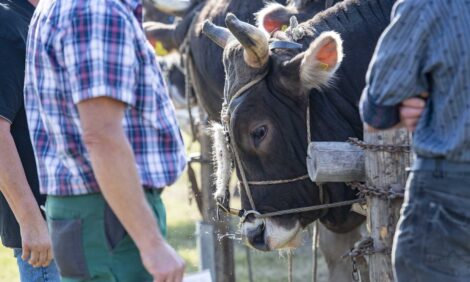



Tuberculosis: Concerns And The Future
Steve Maddox, a dairy farmer from California, tells an audience at the 2010 Annual Meeting of the National Institute for Animal Agriculture, how tuberculosis (TB) has affected his business and the changes he has made to prevent future disturbances.Steve Maddox runs a dairy herd in California. His family started dairy farming at Maddox Farm in 1957 with 14 cows. By 1966 the herd had expanded to 400 head of cattle.
In 1982, Mr Maddox wanted to set up his own farm. After looking extensively across the country for the right plot of land, he built a megadairy on an alfalfa ranch.
The dairy is split into two herd, the RuAnn herd and Maddox Dairy. Steve Maddox runs Maddox Dairy, milking 3,400 head of cows, with 650 dry cows, 4,000 replacement heifers and 2,500 bulls - which are sold across the West coast of the US for breeding.
His brother, Patrick, runs RuAnn Dairy, a pedigree Holstein herd and the basis for the business's dairy genetic programme.
Animal health and welfare is a huge priority, there is staff coverage 24 hours a day to maximise cow/ calf care.
Mr Maddox also insists on maximising the use of vaccines, which he believes are not only better than antibiotics but can make antibiotics more effective.
With this in mind, standard operating procedures are in place on the farm. The majority of his staff are Latinos.
Training and specialisms include genetics, heifer raising, calf and dry cow management, cleaning of equipment,fertility, nutrition and herd health - which includes vaccinations, udders, feet and legs.
Mr Maddox also shows his livestock locally and out of state. Live cattle and embryos are sold internationally. RuAnn is the largest privately owned embryo transport facility.
Being a large unit, artificial insemination (AI) plays an important role along with embryo transfers. Mr Maddox focuses on producing a good selection of cattle, to provide the genetic pool for the entire herd.
TB
RuAnn was a certified TB free herd in 2003. They had survived the 2001 outbreak of TB in California in 2001.
Following on from this, Mr Maddox sat on the National Animal Health Committee for TB.
In 2007, further herds in California tested positive with TB. The first herd, 15 miles away from Maddox Dairy saw 4,000 animals depopulated,with a further 1,000 animals depopulated from a second herd. Both herds had the same strain of TB.
Investigators traced in and traced out all cattle. Mr Maddox was a trace-in herd.
On April 25th, 2008 an eight year old cow which had been born and raised at RuAnn Dairy, tested positive. She had previously tested clean in 2002 and 2003.
Immediately both herds were quarantined.
90 per cent of transmissions occur from cow to cow through exhaled air, spetum, feces, urine or milk.
On examining the results, it was discovered that the strain of TB found on Maddox Farm did not match any previous California TB case.
The source was unknown, however it was believed to have most likely come from an employee.
Over the previous five years, the herd had only brought in 14 animals. However tracing out, the business had sold 14,000 head of cattle over 15 states.
This required 400,000 animals to be tested, with 70 veterinarians working full time and costing a total of around $2 million.
Whilst still looking for the source of the infection, Mr Maddox had all employees tested. The local County Health would only test employees from the RuAnn herd, as they felt there was no risk from the second herd.
Despite Mr Maddox arguing this, only the one herd was tested.
The skin test was at the County's expense, however any further X-rays and office visits, antibiotics etc would be at the dairy's expense.
23 employees were tested. Of them seven tested positive and had further chest X-rays. All chest X-rays came back negative.
Not being able to find a source, Mr Maddox revisited the farm's TB prevention plans.
Prevention
To prevent TB in the herd, Mr Maddox says that having a closed herd, where possible, is the best way to prevent the disease. RuAnn is not a closed herd, as cattle go to shows and a number of visitors come onto the farm.
He also recommends recording individual animal identification and maintaining accurate records.
All animals brought onto the holding should be isolated and tested, including animals already belonging to the herd such as contract reared heifers.
Suspicious sick or dead animals should have samples taken on a regular basis, or an autopsy carried out.
Mr Maddox also says that a TB testing policy for employees should be in place.
The source of the outbreak at RuAnn is still unknown. With this in mind, Mr Maddox recommends that the USDA make Radio Frequency Identification (RFID) be mandatory in the US.
He believes that the government should initiate a strategic plan for the control of infectious diseases on dairies, whilst also controlling the imports of Mexican feeder cattle through additional testing.
Most importantly, Mr Maddox wants the government to reform the immigration regulations to make it easier for workers to come into the US on a legitimate programme, which includes testing for drugs and tuberculosis.
With regard to a TB testing policy on Maddox Dairy and RuAnn Dairy, all employees are tested prior to employment, if they test negative work will commence, and workers will be re-tested every two years. If a worker leaves the US, they will be re-tested on return.
All employees testing positive for a skin test will be sent for an X-ray, positive results from the X-ray mean that employees cannot work until medically released by a physician.
An annual tuberculosis questionnaire has also been implemented.
Mr Maddox says that he is still unsure as to where the disease came from, as the County Health would not let him continue to trace it down.
He hopes that the plans in place will prevent any further incidence's.


